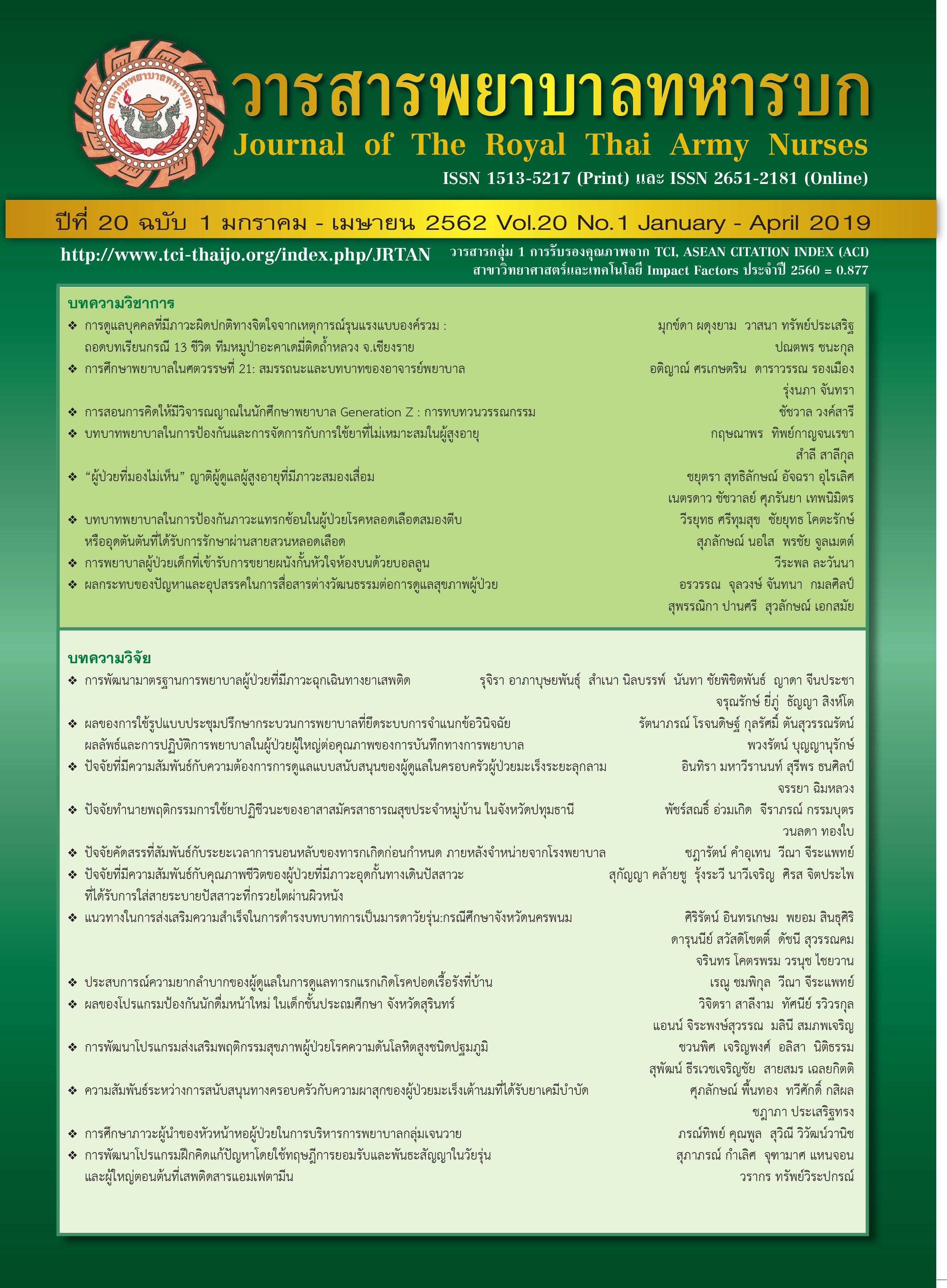The Model Development of Internal Factors Promotion to Protect Drug Substances Abuse of Female Adolescents
Keywords:
Developed the model, Drug substances abuse prevention, High risk female adolescentsAbstract
The objective of the research was to developed the model for internal factors promotion to protect drug substances abuse of female adolescents. The step to create the model were review literature, pilot study about how to adolescents exposed to illicit drugs in Thailand, field study by In-depth interview expertise in branch illicit drugs prevention and treatment, parents and teachers. Moreover did focus group in high risk female adolescents after that analyzed data to do draft model. Evaluated standard of the model by 10 expertise. The name of the model was “POInT In Trust Me Model” Components of the model were Principle of the model = P, Objective of the model = O, Instructor = In, Target group = T, Information /Content of the model = In,Trust activity = Trust and Model evaluation = Me Standard of the model was very good (mean = 3.9, Total 5 scores) and performance manual was very good (mean = 3.71, Total 5 scores)
Downloads
References
Bureau of Drug Prevention and Solution Department Office of the Narcotics Control Board. Concept of drugs prevention among high risk adolescents. 1st ed. Bangkok; 2009. (in Thai)
National Institute on Drug Abuse. Drugs, Brains, and Behavior: The Science of Addiction; 2014.
National Institute on Drug Abuse. “Drug Facts: Substance Use in Woman.” Substance Use in Woman 2015;1-4.
Watthanakrom S, Moonsart S, Neesakul N,Tomornsak P, Wiriya G, Punchaboot S. Drugs situation and Factors influence to take drugs among students in secondary school in Pathumthani province. Thanyarak Institute; 2009. (in Thai)
Pimpuang P, Kanato M. Drugs Resistance among Junior High School in Muang District of Pattani Province. Journal of Education. Prince of Songkla University. Pattani Campus 2016; 27 (1): 137- 146. (in Thai)
Intasit S, Waraengsiri B. Development of Drugs Abuse Prevention Model for Adolescence. The 12th Khonkhaen University Graduate Research Conference 2011; 82-94. (in Thai)
Nilbub S, Suriyajai P, Deepunya R, Chaipichitpan N, Margan S, Meesil W. Drugs addict process: The effect to health and family of drug addicts (Club Drugs). Thanyarak Institute. Department of Medicine. Ministry of Public Health; 2012. (in Thai)
Kongpet C. Factor Influences Narcotic Addition in Female Student, Kalasin Province. Community development dissertation. Faculty of Medicine. Khonkaen University 2011; 54-61. (in Thai)
Chirawatkul S, Saito AS, Boonruang P, Srirahat J, Kongkerd T. Being a Male Drug User and Female Drug User: Meaning of Drugs Use. Journal of Psychiatric Association Thailand 2013; 58(4): 407-420. (in Thai)
Scull et al. Adolescents’ Media-related Cognitions and Substance Use in the Context of Parental and Peer Influences. Journal Youth Adolescence 2010; 39(9): 981-998
Chen HJ, Balan S, Price RK. Association of Contextual Factors with Drug Use and Binge Drinking among White, Native American, and Mixed-Race Adolescents in the General Population. Journal Youth Adolescence 2012; 41(11): 1426–1441.
Rachachan S, & Meekhun S. Life Phenomena of Amphetamine abuse youth. Journal of Education and Social development. 2010; 6 (1): 81- 94. (in Thai)
Suksang S, Tamcharean R, Sangkapan J. Factors That Influence Substance use Risk Behaviors of Middle School Students of Songkhla Province; 2015 (in Thai)
Hawkins JD, Catalano RF, Miller JY. Risk and Protection Factors for Alcohol and Other Drug Problems in Adolescent and Early Adulthood: Implication for Substance Abuse Prevention. Psychological Bullitin. 2016; 112 (1): 64-105.
Ajzen, I. Constructing a TpB Questionnaire: Conceptual and Methodological Considerations. 2006
Wattanaburanon A. Development Research of Love Model for Enhancing Comprehensive Humanization: A Research Program for Higher Education Students. 1st ed. Bangkok; 2016. (in Thai)
Penney, T. ADDIE Model in Safety Training, how does yours measure up!. Terry Penney on inkedin; 2016.
Shek DL,Yu L. Prevention of Adolescent Problem Behavior:Longitudinal Impact of the Project P.A.T.H.S. in Hong Kong. The Scientific World Journal 2012; 1: 1-13.
Huang CM et al. Integrating Life Skills into a Theory-Based Drug-Use Prevention Program: Effectiveness among Junior High Students in Taiwan. Journal of School Health 2012; 82 (7): 328-335.
Anunthasan D. Alternative : Goverment Teachers’ Opinions towards Anti-Drug Policy Based on Sufficiency Economy : A Case study of Petpitayakom school in Phetchabun Province; 2011. (in Thai)
Sattler S et al. Evaluating the drivers of and obstacles to the willingness to use cognitive enhancement drugs: the influence of drug characteristics, social environment, and personal characteristics. Substance Abuse Treatment and Policy. BioMed Central. Germany. 2014.
Wu P. et al.The Relationship between Anxiety Disorders and Substance Use Among Adolescents in the Community: Specificity and Gender Differences. Journal Youth Adolescence. 2010; 39 (2): 177–188.
Hale DR, Viner RM. The correlates and course of multiple health risk behavior in adolescence. Hale and Viner BMC Public Health 2016; (16): 458-470.
Carlo G et al. The Longitudinal Relationships between Rural Adolescents’ Prosocial Behaviors and Young Adult Substance Use. Journal Youth Adolescence 2011; 40: 1192–1202.
Wongpanarak N and Chaleoykitty S. The Role of Nurse in Addiction Counseling. Journal of The Royal Thai Army Nurses 2560; 19 (1): 16-23. (in Thai)
Downloads
Published
How to Cite
Issue
Section
License
บทความหรือข้อคิดเห็นใดใดที่ปรากฏในวารสารพยาบาลทหารบกเป็นวรรณกรรมของผู้เขียน ซึ่งบรรณาธิการหรือสมาคมพยาบาลทหารบก ไม่จำเป็นต้องเห็นด้วย
บทความที่ได้รับการตีพิมพ์เป็นลิขสิทธิ์ของวารสารพยาบาลทหารบก
The ideas and opinions expressed in the Journal of The Royal Thai Army Nurses are those of the authors and not necessarily those
of the editor or Royal Thai Army Nurses Association.






